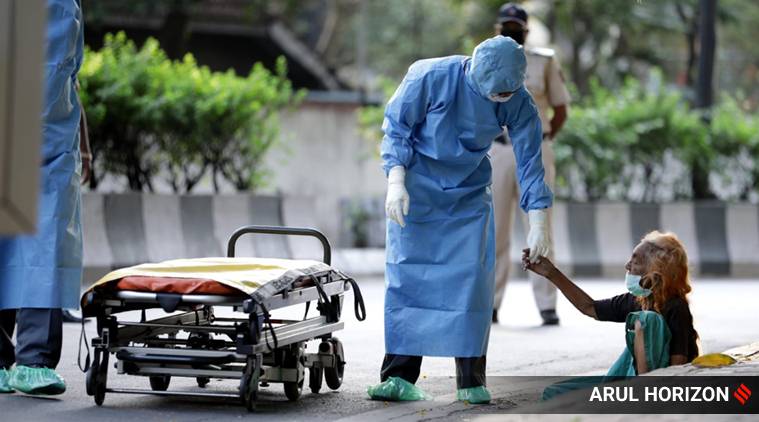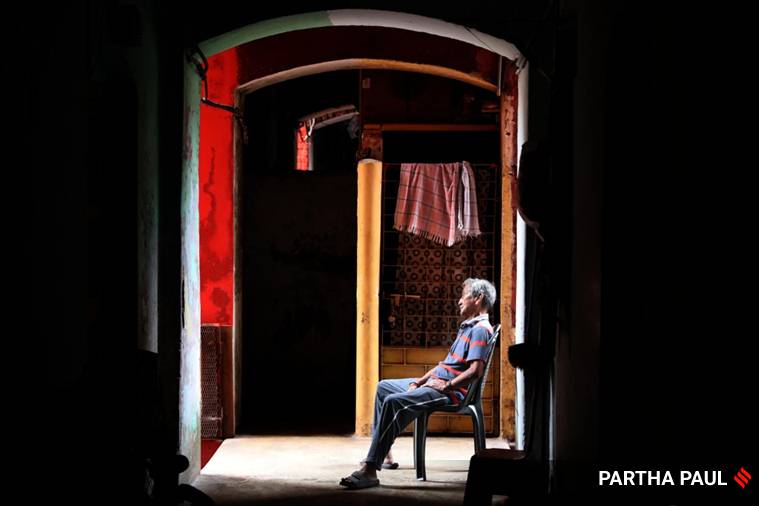 Coronavirus: Health workers help shift an elderly homeless woman with Covid-19 symptoms to a medical facility. (Express Photo by Arul Horizon)
Coronavirus: Health workers help shift an elderly homeless woman with Covid-19 symptoms to a medical facility. (Express Photo by Arul Horizon)
The global death toll of the new coronavirus infection, Covid-19, crossed 100,000 on Saturday– barely 103 days after the World Health Organization first heard of a “mystery pneumonia” in Wuhan, China.
A high percentage of those who have died were senior citizens (aged 60 and above), and those with comorbidities such as diabetes, high blood pressure, heart disease and asthma. Research over the last three months has repeatedly and consistently shown us that the infection affects people differently based on their age and pre-existing health conditions.
Research published in The Lancet Infectious Diseases, for example, argues that the maximum death rate of Covid-19 in the under-60 population could be 1.5 per cent. The infection fatality rate for Covid-19 patients aged 60 and above, based on the same parameters, could be as high as 12 per cent. To be sure, this research uses data from China to draw up models of what could happen in the rest of the world, but the age-based data is concerning.
The fact is that people over 60 who contract Covid-19 are likely to fall severely sick, need hospitalisation and could even die. Early data from India’s health ministry corroborates this: on April 6, 2020, Joint Secretary in the Ministry of Health Lav Agarwal said people aged 60 years and above comprised 19 per cent of Covid-19 confirmed cases but they accounted for a staggering 63 per cent of deaths in India up until then.
Census 2011 data shows that India is home to 104 million senior citizens. Research also shows that at least 20 per cent of Indians are living with chronic illnesses like diabetes and hypertension. (Though this article focuses mainly on the elderly, people with lifestyle/chronic disease are also at risk of severe symptoms if they get Covid-19)
Prevention is better than cure
This is especially true for the elderly. There is already evidence to show that early and extreme physical distancing measures help prevent infection. Denmark managed to keep the infection in check when other European countries were seeing a daily increase in the number of confirmed patients and deaths. India, too, took proactive steps in this respect: by announcing a 21-day, countrywide lockdown on March 24, 2020 (just 14 days after the country saw its first Covid-19 linked death in Karnataka).
Research has shown that strict observance of social distancing measures by 75 per cent of the population, over an extended period of time, could reduce the case mortality rate by 95 per cent compared with peak level (that is, if no action is taken). This is the maximum possible reduction in mortality rate, according to research-based projections.
However, this may not be practical in many parts of the world, for many reasons: losses to the economy, growing unemployment and hunger, lack of healthcare services for other ailments are some of the more compelling ones.
A more moderate level of social distancing – one that focuses on the elderly (also known as a mitigation approach) – could reduce mortality by 41 per cent compared to peak levels. To be sure, this is lower than the 95 per cent that is attainable, but this method is much more practicable and still represents a significant improvement over the peak mortality rates.
Shielding the elderly, particularly, is the next logical step in this mitigation strategy – and it is one that could have far-reaching benefits.
From Explained: As Covid-19 fight rages, how short is the world of nurses?
How to shield senior citizens, and for how long?
The reason the elderly are at risk is because they tend to have poorer immunity and more age- and lifestyle-related diseases such as diabetes. The Ministry of Health and Family Welfare issued an advisory to safeguard senior citizens just as the first confirmed Covid-19 case was reported in India.
So how do you ensure strict quarantine for senior citizens?
On a day-to-day basis, this would mean applying all the home quarantine measures to senior citizens (one caregiver may stay with the elderly, to make sure they have everything they need, but even this caregiver must maintain at least 3-6 feet of distance from the elderly person at all times).
As far as possible, healthcare to the elderly should be provided at home. Evidence from other countries has shown there is a higher chance of getting the infection in a hospital setting where there is an influx of Covid-19 patients. This, even as the government has designated three different types of Covid-19 healthcare centres and they each have detailed guidelines to reduce the transmission of infection.
 Covid-19: A senior citizen participates in a Good Friday service in Kolkata while staying at home amid the nationwide lockdown to contain the spread of coronavirus. (Express Photo by Partha Paul)
Covid-19: A senior citizen participates in a Good Friday service in Kolkata while staying at home amid the nationwide lockdown to contain the spread of coronavirus. (Express Photo by Partha Paul)
Moreover, the health of Covid-19 patients can deteriorate suddenly. Identifying households with senior citizens and tagging them for special attention and regular follow-ups could help in early diagnosis and treatment of infections in the elderly – before the need for hospitalization arises.
One of the ways in which Heidelberg, Germany, has managed to keep its Covid-19 death rate low is through corona taxis – a kind of mobile clinic which takes doctors to the homes of patients, to identify those who are likely to develop lung problems and admit them to hospital. In India, we could set up a similar system to check in on those over 60 – identifying cases early will help us monitor their condition and administer appropriate treatments before their health starts to deteriorate severely.
For now, the vast majority of people who have contracted the infection in India are between 21 and 40 years old – an age group that is at a lower risk of dying, unless they have comorbidities. But India also has a high number of households where three generations live together – mingling with children, even within the home, could put older people at risk of infection at this time, as children could be asymptomatic carriers of the infection.
A health communication research group in Germany has found that even when the elderly knew about the risk this infection poses to their health, they failed to comply with “important protection behaviours”. This needs to change. If India is to reduce its overall death toll, and end this outbreak at the earliest, we need to safeguard our most vulnerable people. Talking to senior citizens and their families, informing them of the very real risks of the disease, could save lives at this point.
This is part two of a five-part series, supported by myUpchar. The first article focused on Four things India can do today to break the Covid-19 chain faster. Nachiket Mor, PhD, is Visiting Scientist, The Banyan Academy of Leadership in Mental Health. Manuj Garg, PhD is Cofounder of myUpchar. In the next article, they will talk about unlocking every avenue for healthcare in India.